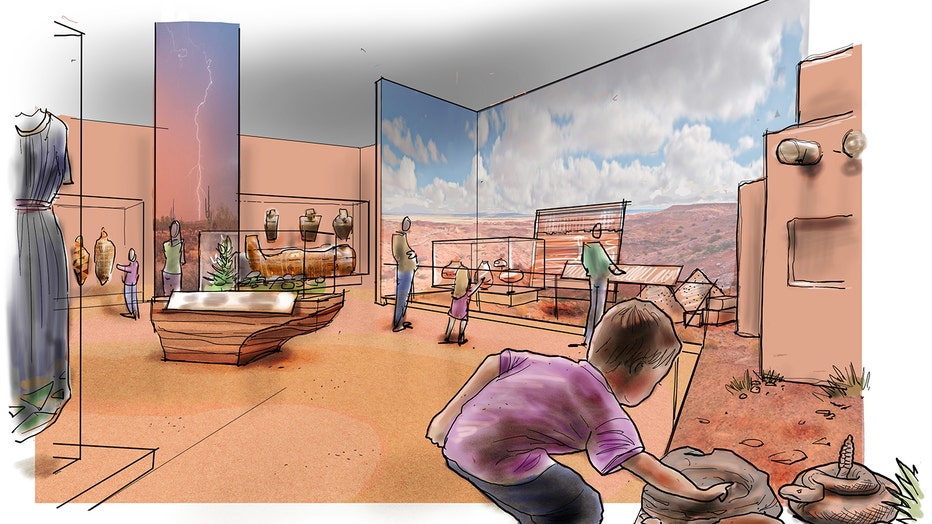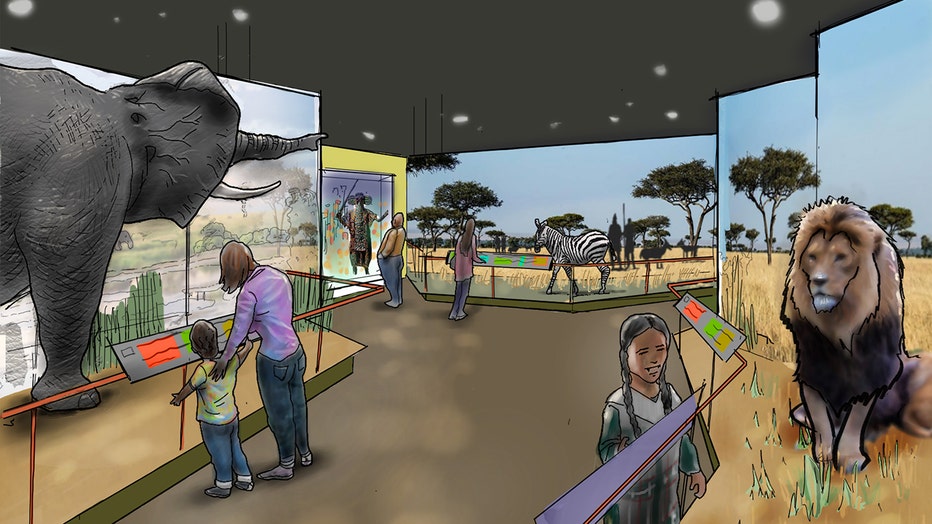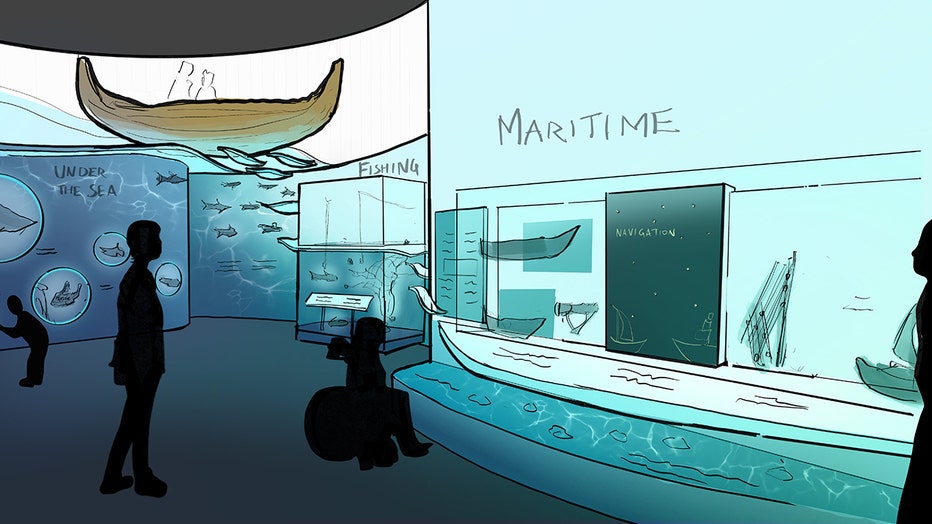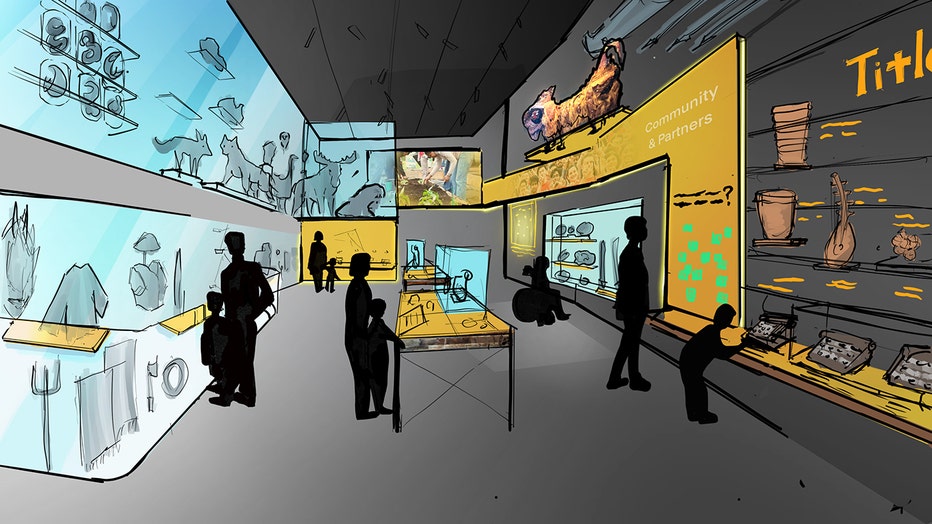Milwaukee Public Museum sketches; 'Living in a Dynamic World' gallery
MILWAUKEE - Milwaukee Public Museum (MPM) and exhibit design partner Thinc Design unveiled sketches on Tuesday, May 9 of the Future Museum’s Living in a Dynamic World gallery.
A news release says each gallery, or group of related exhibits, will focus on a specific overarching theme, and its many dioramas and individual features will help visitors learn about the interconnectedness of nature and culture tied to that larger concept.
The release goes on to say in Living in a Dynamic World, visitors will take an unconventional journey across the world and learn about five distinct landscapes: deserts, the Arctic, islands, grasslands and mountains.
Each immersive landscape will include stories of distinct cultures—including a focused look at a specific individual or group of people and other species who call the landscape home today—and will show visitors unique ways of life that have developed in continuous dialogue over generations with these landscapes. Cultural counterpoints will highlight other examples of life in each landscape, helping illustrate both distinguishable characteristics about each landscape and the ways different cultures adapted to living in these types of environments over time.
The Mixing Zones are two special, flexible spaces that will allow Museum staff to rotate displays of collections items. With one Mixing Zone dedicated to research and science and the other focused on culture, each space will present visitors with new ways to look at and experience the four million collections items in the Museum’s care.
Deserts
In the Deserts hall of the gallery, visitors will learn about the characteristics of the world’s deserts, the diversity of life and ways of living in desert environments and how desert residents adapt to and shape their environment. Supported by the wide range of ceramics, textiles and agricultural items in the Museum’s collections, the Deserts hall will spotlight the distinct environment of Northeastern Arizona, exploring how the landscape’s dynamics – like water access, extreme temperatures and unique flora and fauna – have shaped life past and present for its residents.

Cultural Case Study: Hopi Nation
At the center of cultural exploration in the Deserts will be the Hopi Nation. Visitors will learn about the cultures and traditions the Hopi people have developed in response to their environment, as well as how they have adapted their day-to-day habits to meet the land.
Among the exhibits in this hall, visitors will see a replica of a traditional Hopi dwelling and learn about how the land is used to build shelter. The exhibits will also highlight Hopi pottery from the Museum’s vast collections and tell stories about how the landscape’s resources have influenced artisan traditions.
The Hopi Nation are a living, thriving community who practice traditions that are hundreds of years old. In the Future Museum, visitors will be able to learn about this contemporary culture while also looking back in time to see what has changed and what has remained the same.
Cultural Counterpoint: Ancient Egypt
The Deserts will also take visitors thousands of miles across the globe and thousands of years into the past with a cultural counterpoint, Ancient Egypt. These exhibits will explore how the desert impacted ancient Egyptians’ beliefs and practices around death, answer questions about why mummies were made in the first place and dive into the symbols, icons and myths connected to death traditions. On display in these exhibits will be collections items including funerary objects and a sarcophagus.
Rattlesnake Button
Hidden within the desert scenery, visitors will have to find the rattlesnake button—continuing a cherished tradition from the current Museum and sharing that spirit of discovery with others. Exhibits will also explore the ways humans have had to adapt their footwear to protect themselves from snake bites.
Richard & JoAnn Beightol Hall: Grasslands
Grasslands and plains are home to an abundance of life, including our planet’s largest land animals and most bountiful agricultural areas.

African Serengeti Scene
In the Grasslands, visitors will be immersed in the African Serengeti. Exhibits will showcase the individuals, communities and animals who reside in that particular grassland – including Timba the Elephant and Simba the Lion, two familiar features currently on display at MPM.
Cultural Diversity in the Serengeti
Exhibits in the Grasslands will also explore the people and human cultures of the Serengeti, and how those communities and customs have been shaped by the landscape.
The Grasslands will also bring visitors back to the American Plains to look at Indigenous Plains peoples and how their environment is similar and different.
Arctic
In the Arctic hall, visitors will learn about one of the most extreme landscapes on the planet and how, despite that, the land provides for a wide variety of life forms and cultures.

Cultural Case Study: Sami
The Arctic will put a cultural spotlight on the Nordic Sami people. A key immersive scene will situate visitors on a vast northern-European tundra during a midsummer night, where dozens of reindeer will munch on moss against the background of a dusky pink sky, the summer sun still above the horizon at midnight.
Exhibits will examine how the Sami have shaped and been shaped by their Arctic landscape through adaptations in clothing and insulation, in how they get their food, fuel, water and other resources, and in their domestication of reindeer. Visitors will also be invited into a traditional Sami tent, or lavuu, to warm up and immerse themselves into the scene while learning more about Sami culture and customs.
Cultural Counterpoint: Inuit
Another scene will illustrate a different Arctic landscape, culture and time of year: the Inuits on the North American ice during a midwinter day. Walruses from the Museum’s collections will rest on ice floes against an immersive wallpaper and projection surface that creates a starry night sky shimmering with the Northern Lights. Stories about hunting and ice fishing will teach visitors about how residents of the Arctic adapt to their environments to get food.
Islands
In the Islands hall of the gallery, visitors will learn about the impact of isolation on nature, including stories of speciation and what it means for a certain species to exist in a limited geographical area. Visitors will also learn about islands that aren’t so remote, and instead help connect people and organisms to larger land masses.

The exhibits within the Islands hall focus on life and cultures in the South Pacific, as well as an Indigenous people of Japan, the Ainu.
Seafaring and Maritime Navigation
In a series of scenes that start on the surface of the water and progressively dive deeper into the sea, visitors will learn about maritime navigation and how people have gotten around islands. These exhibits will also explore the different animals and fish that live in the water, the impact that pollution has on both the ecology of oceans and islands and the communities that rely on the land for resources and industry.
This area is also one of the rare moments where there will be a window in the gallery. The natural light from outside will be used to add dimension and movement to the underwater scene as a boat floats overhead.
Mixing Zones
The Future Museum’s Mixing Zones will be two gathering spaces that will provide rare, behind-the scenes views into the collections’ storage areas and turn the Museum "inside out." Items on display in the Mixing Zones will be frequently rotated, allowing visitors to see new-to-them items regularly and allowing the Museum to layer in even more educational opportunities as visitors gain access to items and ideas that have previously not been visible.

Three-story Showcase
Visible from multiple floors of the Future Museum, a dramatic glass case will show off a breadth and variety of items from the collections in the Museum’s care, ranging from ancient fossils and glittering gems, to boats, textiles, children’s toys and taxidermied specimens, such as Samson the gorilla. Placards and signage will help visitors understand the stories behind the objects and specimens on display.
Burke Foundation Mixing Zone
Made possible through a generous $2M gift from the Burke Foundation, the Burke Foundation Mixing Zone will give an inside look at what happens behind the scenes at a museum. An enormous window will offer views into the collections storage areas, where curators and scientists care for and study more than 4 million priceless artifacts and scientific specimens in the Museum’s care. In addition to giving a view into science-related collections and research, the Burke Foundation Mixing Zone will be a space for hands-on science education.
The Burke Foundation Mixing Zone will also feature a permanent exhibit highlighting Carl Akeley’s famous Muskrats diorama, the first "Milwaukee-style" exhibit which set the standard for natural museum histories around the world and is currently on display at MPM.
Cultural Mixing Zone
Situated next to the Living in a Dynamic World gallery, the Cultural Mixing Zone will remind visitors that different cultures offer varying perspectives on the Museum’s collections, each other and the world. In the Mixing Zone, this idea will be demonstrated primarily through cultural and zoological collections items.
The Cultural Mixing Zone will be a space where cultural experts from both within and beyond the Museum can share what they are learning, where skilled artisans and storytellers can practice their craft.
Future announcements
Throughout the past two months, Milwaukee Public Museum and its exhibit design partners at Thinc Design have been rolling out previews of each permanent gallery to exist in the Future Museum, providing an inside look at a sampling of exhibits, collections items and features visitors can expect to encounter upon the Future Museum’s opening in late 2026.
The final gallery announcement will take place on May 23, introducing the Rainforest gallery, Puelicher Butterfly Vivarium and the Bucyrus Rooftop Terrace. The Rainforest will take visitors to the tropics to learn about the biodiversity that flourishes in tropical rainforests and the life rainforest climates support. The Puelicher Butterfly Vivarium will welcome visitors into a warm, lush greenhouse thriving with real tropical plants and live butterflies flying freely throughout the space. The Bucyrus Rooftop Terrace will be a gathering space to reconnect visitors to the outdoors and natural world.

